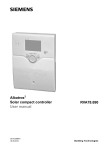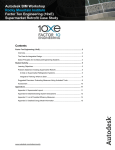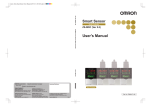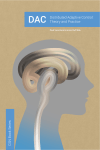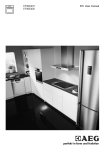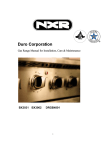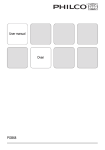Download 5995304697 Frigidaire Carbon Monoxide (CO)
Transcript
Technical Service Manual PROCEDURES FOR REPAIR AND ADJUSTMENT OF GAS COOKING PRODUCTS TO MINIMIZE CARBON MONOXIDE (CO) LEVELS 2008 All Rights Reserved Electrolux Major Appliances Publication # 5995304697 INTRODUCTION This Technical Assistance Manual will provide the technician with information and procedures necessary to properly understand safe Carbon Monoxide levels. Test for the possibility of excessive levels and make necessary adjustments and repairs to gas cooking products should excessive levels exist. This manual does not replace the Product Service Manual or the Installation Instructions provided with the Product or the Use and Care Guide. In certain instances this Manual may refer to other reference manuals for additional goals and information. GOALS and OBJECTIVES The overall goal of this Manual is to equip the technician with a basic understanding of the existence of dangers of carbon monoxide (CO) and provide procedures for testing for and correcting dangerous levels. The specific objectives of this manual are to have the technician understand: What Carbon Monoxide is and how it is produced. How it affects the human body. How to test and measure levels of Carbon Monoxide produced by gas cooking products. How to adjust and repair gas cooking products to minimize Carbon Monoxide levels. This service manual is intended for use by persons having a license to service gas products in areas that require such a license as well as electrical and mechanical training and a level of knowledge of these subjects generally considered acceptable in the appliance repair trade. Electrolux Major Appliances cannot be responsible, nor assume any liability, for injury or damage of any kind arising from the use of this manual. 2 TABLE OF CONTENTS INTRODUCTION.................................................................................................................................................... 2 TABLE OF CONTENTS ........................................................................................................................................ 3 THE NATURE OF CARBON MONOXIDE (CO) WHAT IS CARBON MONOXIDE (CO) ........................................................................................................ HOW DOES IT AFFECT THE HUMAN BODY............................................................................................ HOW CAN CONSUMERS BE PROTECTED FROM CO POISONING ...................................................... CARBON MONOXIDE EMISSION STANDARDS ...................................................................................... STANDARDS OVERVIEW .......................................................................................................................... 4 4 5 6 6 HOW CARBON MONOXIDE IS PRODUCED BURNER OPERATION ................................................................................................................................ MIXING GAS AND PRIMARY AIR .............................................................................................................. COMBUSTION ............................................................................................................................................ PROPERLY BURNING FLAME .................................................................................................................. TOO MUCH PRIMARY AIR ........................................................................................................................ TOO LITTLE PRIMARY AIR ........................................................................................................................ OVER FUELED BURNER .......................................................................................................................... FLAME QUENCHING .................................................................................................................................. GAS PRESSURE AND PRESSURE REGULATORS ................................................................................ MEASURING GAS PRESSURE.................................................................................................................. APPLIANCE REGULATOR TEST .............................................................................................................. 7 7 8 8 9 10 10 11 11 12 13 TESTING FOR CARBON MONOXIDE IN THE HOME TO TEST FOR CARBON MONOXIDE ........................................................................................................ COOKTOP MEASUREMENTS.................................................................................................................... 13 13 ADJUSTMENT AND REPAIR PROCEDURES BAKE BURNER ADJUSTMENT ................................................................................................................ BROIL BURNER ADJUSTMENT ................................................................................................................ CONVENTIONAL SURFACE BURNERS.................................................................................................... SEALED BURNERS .................................................................................................................................... SURFACE BURNERS DO NOT OPERATE PROPERLY WHEN OVEN IS IN OPERATION................................................................................................................ CUSTOMER RELATED ISSUES RED TAGGED PRODUCTS ........................................................................................................................ EXPLAINING INSPECTION RESULTS TO THE CUSTOMER .................................................................. 3 14 14 15 16 16 17 17 The Nature Of Carbon Monoxide (CO) THE NATURE OF CARBON MONOXIDE (CO) WHAT IS CARBON MONOXIDE (CO)? Carbon Monoxide is a chemical compound of Carbon and Oxygen with the chemical symbol CO. CO is an undetectable gas, which means that it has no taste, odor, color and does not irritate the skin or eyes. It has a specific gravity of 0.98, which means it is slightly lighter than air and disperses quickly and freely. Because it is undetectable, and because it is toxic when inhaled, it is often referred to as the "Silent Killer". Because of the changes in construction of homes to make them more energy efficient, homes are sealed tighter than ever before. Consumers are being made aware of the dangers of CO in the home over the last few years. In 1993, when CO detectors first went on sale, 400,000 were sold. In the next year, 1994, sales leaped to 3.85 million. Today millions of consumers have CO detectors in their homes. CO is a by-product of the incomplete combustion of petrol-chemicals. This occurs when there isn't enough oxygen to combine with the carbon that is released. Below is a list of items commonly found in the home that may be sources of CO: Unvented Gas Cooking Appliances Gas, Oil, Wood or Coal Furnaces Water Heaters Unvented Gas Clothes Dryers Barbecue Grills Tobacco Smoke Fuel Burning Space Heaters Wood Burning Fireplaces / Inserts Blocked Chimney Gas Refrigerators Automobile Exhaust (Attached Garage) Gas Pool or Spa Heaters Ceiling Mounted Unit Heaters Any Other Combustion Based Appliance CO detectors in the home will alert a customer that there is CO in the air in concentrations that may be harmful to the inhabitants. A consumer should then call a professional to locate the source of the CO contamination and try to find a solution. This is often done by the local fire department or utility company. For those who do not have a CO detector in their homes, there are some visual clues that there may be excessive concentrations of CO in the air. These are listed below: 1. Loose or disconnected ventilation or chimney connections. 2. Rust, scale, soot or other deposits on the burners, in the heat exchange, vent or any appliance clean out. 3. Debris or soot falling from chimney, fireplace or appliance. 4. Moisture on insides of windows. None of these visual clues is conclusive, and should not be used as anything more than clues that there may be a CO problem. All people are in danger of CO poisoning when they are exposed for extended periods of time, or if it is high enough concentrations. Certain groups of people have lower tolerances than others, and should avoid exposure. Below is a list of these at-risk groups: Infants / children Pregnant women People with Angina (Chest Pains) Anyone who has trouble breathing Elderly people Individuals with Anemic Conditions HOW DOES CO AFFECT THE HUMAN BODY? Carbon Monoxide can cause a serious health risk because it can only be detected using special instruments. If one does not recognize the symptoms of CO poisoning, or is in a place where contamination is not very concentrated and therefore not causing these symptoms very quickly, they may not even know they are being affected by CO poisoning. It is important to know these effects so that you can avoid permanent injury or death. The particles in the blood that carry oxygen from the lungs to the rest of the body are called Hemoglobin Cells. They attach to the oxygen, which comes into the lungs as a Diatomic Particle (which means there are two atoms stuck together), and flow throughout the body. Once a Hemoglobin Cell has released its oxygen to be used by the body, it will carry the carbon dioxide (the same chemical released in normal combustion) by-product back to the lungs, where it is exhaled. 4 The Nature Of Carbon Monoxide (CO) The second type of CO sensor technology is called Biomimetic Sensing. A Biomimetic Sensor mimics the human hemoglobin cells to attract and capture CO particles in ambient air, then tests the amount collected by measuring the electrical resistance caused by the oxidized particles between three electrodes. When CO is inhaled, it is in the same shape that a diatomic oxygen particle is, and is 242 times more attractive to Hemoglobin Cells than oxygen is. It can therefore replace oxygen in the blood and reduce the available oxygen for major body organs. Even though the blood will carry CO just like normal oxygen, and even though CO does contain one oxygen atom, the bond between the oxygen and the carbon is so strong that the body cannot use it to nourish the cells. It remains attached to the hemoglobin, and does not allow the carbon dioxide the body is producing to be expelled. A person who is breathing too much CO will appear to be suffocating, even though they are able to inhale and exhale freely. The Underwriter Laboratories 2034 Design and Performance Standards (revised in 1995) regarding CO detectors dictates the following alarm levels: Low Battery Alarm: Intermittent Chirping Signal CO LEVEL 400 PPM 200 PPM 100 PPM 15 PPM Below is a list of the most noticeable symptoms of CO Poisoning: Mild Exposure: Flu-like feeling, slight headache, irritability, nausea, vomiting. Medium Exposure: Disorientation, fatigue, confusion, throbbing headache, drowsiness. Extreme Exposure: Vomiting, collapse, coma, brain damage, heart and lung failure, death. ALARM TYPE/TIME STANDARD Must alarm every 15 minutes Must alarm every 35 minutes Must alarm within 90 minutes Will alarm every 30 days Low Level CO Warning: An intermittent warning consisting of a 3 second alarm every 4 minutes (warns of chronic CO developing problems within a home) Full CO Alarm: A continuous alarm signaling that CO is at or is approaching hazardous levels. The revised UL 2034 standard allows for one other feature: The Test / Silence Button If a warning or full alarm sounds and the consumer presses the Test/Silence Button, the alarm will be silenced for four to six minutes. After this period, the alarm will begin if the CO level has not dropped. If CO have returned to a safe level, the alarm will return to normal operation. The Consumer Products Safety Commission (CPSC) states that there are about 300 accidental deaths resulting from CO exposure annually. The American Medical Association puts the number closer to 1500 accidental deaths per year. The University of Kentucky Medical Center reported that 24% of flu patients are actually suffering from mild exposure to CO, and the Journal of Clinical Toxicology reported that 30% of CO poisonings go unreported. CO is rated as the leading cause of poisoning deaths in the United States. The Consumer Product Safety Commission (CPSC) recommends at least one CO detector be installed in every home. They further recommend that it be mounted in or near the sleeping area, and that multileveled homes should have detectors mounted on each level. HOW CAN CONSUMERS BE PROTECTED FROM CO POISONING? The most common form of in-home protection available to consumers are Carbon Monoxide Detectors. These detectors will sense the level of CO concentration in the ambient air and emit an audible alarm when those levels are too high. All CO detectors must be UL (Underwriters Laboratories) approved under 2034 - Design and Performance Standards (revised in 1995). NOTE: CO DETECTORS MUST NOT BE MOUNTED DIRECTLY ABOVE AN APPLIANCE, they should be installed a minimum of 8 to 10 feet from any combustion appliance. Most CO detectors will have a test button that can be pressed to verify proper operation. Most manufacturers recommend that the test button be pressed to test the unit weekly. Battery powered units will require battery replacements every two years at the longest, and all units require sensor pack replacements every two years. Some manufacturers will offer extra features such as extended-life sensor packs or indicator lights to ensure proper operation. There are two common types of CO detectors on the market. Most manufacturers (over 30 different manufacturers on the market) use the Taguchi/Figaro Electro- Chemical device, a technology that's been around for many years. They usually require a 120V AC installation. 5 Carbon Monoxide Emission Standards CARBON MONOXIDE EMISSION STANDARDS Ambient Level CO Exposure Standards There are many ways that Carbon Monoxide measurements can be stated. One of the most common forms is the Diluted or Atmospheric reading which is reported as a single gas, and is stated in parts per million (PPM). Most ambient levels are measured in this way. CO can also be measured in percentage (percent by volume), but this is uncommon. CO Air-Free (CO A/F) is a calculation that allows a carbon monoxide reading to be stated as an Undiluted or Absolute reading in PPM. For this reason, this is the method used most commonly to measure appliance and heating equipment emissions. The CO A/F measurements is computed from the CO and O2 measurements. It is a concept for determining the amount of CO present in a sample of air by compensating for the amount of excess air provided by the burner. Excess air from a burner dilutes the products of combustion, causing a CO test to be understated. A CO A/F measurement eliminates excess air dilution. The American Gas Association publishes CO emissions for appliances and heating equipment through American National Standards Institute as ANSIZ21.1. These maximums are stated in CO A/F and do not necessarily relate to human exposure standards. These Standards are applicable: 800 PPM Maximum concentration allowed from an unvented gas oven. NON-VENTED GAS COOKING APPLIANCES in residential application are normally used for short periods of time. The CO generated during operation will disperse to the air in the house and be purged to the outside through normal air exchange. VENTED APPLIANCES such as furnaces and hot water heaters are limited to 400 PPM, as they are expected to operate at full output for extended periods. Normal operation can vary from a few hours to days at a time. All vented appliances are required, by law, to be connected to a properly operating venting system. Vented appliances are safe during normal operation, but can become hazardous if the venting system fails to remove the products of combustion. Instruments can now determine the CO A/F reading by measuring both CO and O2 levels then calculating the formula below. 20.9 Measured X CO (in PPM) = CO Air Free 20.9 - O 2 STANDARDS OVERVIEW Various Authorities have set human CO exposure standards: CPSC Maximum exposure level of an average of 15 PPM over 8 hours; maximum average of 25 PPM over 1 hour. EPA Maximum level 9 PPM over 24 hours as the residential interior ambient level maximum standard. (Note: A properly ventilated home will have a normal CO level less than 5 PPM). OSHA Maximum of 50 PPM over 8 hours in a work environment. 6 How Carbon Monoxide Is Produced HOW CARBON MONOXIDE IS PRODUCED BURNER OPERATION MODEL NO. XXXXXXXXX XXXXXXXXXXX SERIAL NO. XXXXXXXXX XXXXXXXXXXX XXXXXXXXXXX XXXXXXXXXXX 120 V 60HZ 15A The unit used to measure the amount of heat a gas burner produces is called the British Thermal Unit (BTU). All gas burners and fuel gasses have BTU ratings. This can be compared to the wattage of an electrical heating element. Most surface burners used on gas ranges / cook tops have burners rated between 9,000 and 12,000 BTUs on natural gas installation under 2,000 feet above sea level. The burner is derated by 4% per 1000 feet. The BTU rating is listed on the serial label attached to the product. (See Figure 1) XXXXXXXXXXXXXXXXXX XXXXXXXXXXXXXXXXXX Figure 1 In order to understand how a burner operates, you must be familiar with the following terms. (See Figure 2) GAS This is the fuel used by the burner, either natural or L.P. PRIMARY AIR This is the air mixed with gas in order to make the gas combustible. Gas Primary Air Primary Air SECONDARY AIR This is supplemental air or ambient air surrounding the flame. AIR/GAS RATIO XXXXXXXXXXX XXXXXXXXXXX Figure 2 Comparison of amounts of fuel, gas and air to act as primary and secondary air. For proper operation, a burner needs the correct amount of gas mixed with the correct amount of air. This is called a correct air/gas ratio. A correct air/gas ratio will result in a flame that is stable without yellow tips. The ratio depends upon the fuel gas type being used. Ten cubic feet of air is needed to completely burn one cubic foot of natural gas( 10 to 1 ratio, 10:1) and twenty-four cubic feet of air is needed to completely burn one cubic foot of L.P. gas (24 to 1 ratio, 24:1). (See Figure 3) 10 cu. ft. Air 1 cu. ft. Gas Figure 3 When broken down into primary and secondary air, 70% to 80% of the total air required is mixed with the gas as primary air. The remaining 20% to 30% is pulled into the flame as secondary air. Air/Gas Mixing MIXING GAS AND PRIMARY AIR Gas flows through the orifice (metering device) from the valve. (See Figure 4) The diameter of the hole in the orifice determines the amount of gas entering the burner. The size of the hole in the orifice is based upon the BTU rating of the gas, the regulated pressure of the gas in the manifold, and the BTU rating of the burner. Primary Air Primary Air Gas Figure 4 7 How Carbon Monoxide Is Produced As the pressurized gas stream flows out of the orifice and into the burner, a vacuum is created around the gas flow. (This is called Aspiration) Primary air is pulled in by this vacuum through the openings in the base of the burner or between the burner and the orifice, and then mixes with the gas as it passes through the burner tube on the way to the burner head. (See Figure 5) Gas Primary Air Orifice The amount of primary air pulled in by the vacuum is determined by the air shutter opening, (Older models this air shutter was adjustable. On newer ranges, this is a fixed opening), or the gap between the orifice and the burner base on models without an air shutter. Air Shutter Opening Primary Air Figure 5 The gas must be injected straight into the burner in order to create enough vacuum to pull the right amount of primary air into the burner. If the gas enters the burners at an angle, it will not create enough vacuum to pull the proper amount of primary air to mix with gas entering the burner. The loss of this air will cause yellow tipping on the flame coming from the burner. You will see the same problem if the gas pressure is low, and / or the orifice is distorted in any way. When you have the proper amount of air and gas entering the burner, the flame will burn clean and steady, without yellow tips and you will have the correct BTU's out of the burner. The air / gas mixture must be supplied to the burner in proper amounts to match the burning speed of the burner to obtain a properly burning flame. Yellow Tipping in Outer Envelope Decreasing the primary air will result in a lazy high flame with a lot of yellow as you slow the speed at which the gas burns. Increasing the primary air increases the burning speed of the gas and can result in the flame lifting away, and a loud sound to come from the burner. (See Figure 6) A lazy flame that occasionally leaps upward away from the burner, soot, and a chemical odor are a sure sign of incomplete combustion. Outer Cone Inner Cone Unburned Air/Gas Figure 6 COMBUSTION Because gas cooking appliances are not vented to the outside, all by-products from the combustion of the gas will remain in the room. When incomplete combustion occurs, the CO discharge will increase and possibly the Aldehydes. Flame Quenching FLAME QUENCHING occurs as a result of the gas flame cooling before the supplemental air (Secondary Air) can mix with the gas flame for complete combustion. One of the most common causes of flame quenching is the burner grate too close to the burner head, resulting in the flame contacting the bottom of the pan. The pot will absorb the heat before complete combustion can take place. (See Figure 7) Figure 7 8 How Carbon Monoxide Is Produced OVER FUELING THE BURNER occurs when the gas supplied is too large for the burner. The flame size will exceed the burner BTU rating. The most common cause is an oversized or enlarged orifice. PROPERLY BURNING FLAME Outer Envelope A properly burning flame has three distinguishable components: (See Figure 8) Outer Cone Inner Cone 1. Inner Cone 2. Outer Cone 3. Outer Envelope Unburned Air/Gas Figure 8 NOTE: Depending on the lighting in the room, the outer envelope may not be easily seen. The outer cone surrounds the inner cone. The outer cone is the hottest part of the flame. Secondary air is drawn into the flame at this point and accelerates combustion. As the by-products from the inner cone move into the outer cone, they are burned and transformed into harmless Water Vapor (H2O) and Carbon Dioxide (CO2). If there is not enough secondary air (or if it is poorly ventilated and stagnant), this process cannot completely occur. (Flame Quenching is one of the most common causes.). This will allow some harmful by-products from the inner cone to slip into the outer envelope. Outer Envelope Outer Cone Inner Cone Pushed Through Outer Cone The combustion process is completed by the time the chemicals reach the outer envelope that surrounds the outer cone. Carbon Monoxide and Water Vapor exiting the outer cone cause the glow of the Outer Envelope. Flame Lifts Off Burner Burner Blowing TOO MUCH PRIMARY AIR If the primary air is increased higher than 10 to 1 Natural or 24 to 1 L.P., the mixture will burn at a faster speed. The additional primary air results in a larger volume of air/gas mixture flowing into the burner head. This increase in pressure and faster burning flame will result in the flame lifting away from the burner and sound similar to a blow torch coming from the burner. This process will disrupt the structure of the flame. (See Figure 9) Figure 9 This disruption of the inner cone will increase levels of the harmful by-products, CO and Aldehydes, coming from the burner by reducing the amount of secondary air mixing with the air/gas mix coming from the burner. This secondary air is needed to convert CO and Aldehydes into the safe by-products of CO2 and H2O. Main-Top Primary Air NOTE: Burners without mixing tubes (See Figure 10) will have a blowing flame for the first minute of operation. The cold burner will allow an increase in the amount of primary air mixing with the gas. When the burner warms up, the amount of primary air entering the burner is reduced and the flame will settle. Sub-Top Primary Air Gas Figure 10 9 How Carbon Monoxide Is Produced TOO LITTLE PRIMARY AIR Yellow Tipping in Outer Envelope A reduction in primary air will slow the burning process and result in the inner cone rising higher in the flame. This will cause less burning in the inner cone and allow a larger amount of by-products to pass into the outer cone. Outer Cone Inner Cone Unburned Air/Gas This lack of air will cause the outer cone to decrease in size, and it will not consume the amount of by-products coming from the inner cone. Some of these by-products flow into the outer envelope, where the carbon is burned. This shows up as a yellow tipping on the top of the burner flame. (See Figure 11) Figure 11 OVER FUELED BURNER Yellow Tips & Soot Can Appear In Extreme Cases The over fueling of a burner may be caused by: 1. Excessive gas pressure entering the burner. 2. The BTU rating of the gas is too high for the burner. 3. The metering orifice is too large for the burner. Long Inner Cone Flame To Tall It is difficult to determine if the burner is over fueled or if it is getting too much primary air. Both cases will allow the flame to lift away from the burner. (See Figure 12) Flame Lifts Off Burner The most noticeable difference on an over fueled burner is that the flame is closer to normal, and the burner has less of the blowing sound than what is present with too much primary air. Figure 12 The best way to distinguish between an over fueled burner or too much primary air, is to open or close the air opening in the burner. If the closing of some of the air opening, therefore reducing the amount of air entering the burner, lowers the flame level to normal, the problem is too much primary air, not too much fuel. Outer Cone 5/8” If reducing the primary air does not correct the problem, turn the orifice hood down toward the valve while observing the flame. If this procedure brings the flame back to normal, the problem is an over fueled burner. Cooktop Burner Top burners should have a cone length of approximately 5/8". (See Figure 13) Figure 13 Oven burners should have a cone length of approximately 5/8" with the oven bottom and flame spreader remover. (See Figure 14) 5/8” Outer Cone Bake/Broil Burner NOTE: Some lift off of the flame with the oven bottom and flame spreader removed is normal. For L.P. installation of models without adjustable orifices, the range must have a L.P. conversion kit installed. This kit will contain the proper sized orifice, and on some burners, a new air shutter. Figure 14 10 How Carbon Monoxide Is Produced FLAME QUENCHING 3/4” As mentioned earlier, flame quenching occurs when the flame is cooled before complete combustion occurs. The height of the surface burners in relation to the burner grates should always be closely examined, this distance should be at least ¾" from the top of the burner to the top of the grate. (See Figure 15). If the grates are too close and the flame comes in contact with the burner, the flame will cool causing incomplete combustion. Grates being too close to the burner can be caused by wrong grates, bad top or bent burner. Figure 15 1-1/4”” The height of the surface burners in relation to the burner grates on sealed burner model products should always be closely examined. This distance should be at least 1¼" (See Figure 16) with the cast cap removed from the burner and checking from the top of the burner body to the top of the grate. If the grates are too close and the flame comes in contact with the burner, the flame will cool, causing incomplete combustion. Grates being too close to the burner can be caused by wrong grates, bad castings, burner is not molded flat or burner is not mounted correctly in cook top. Figure 16 An over fueled burner, or too much primary air, will give a high flame and can contact objects like flame spreaders and cooking pans, causing the flame to cool. Always check the flame as well as the proper distance between grates and flame spreaders. Flame Quenching When quenching occurs, the customer may complain of odor. This is a result of the flame cooling and the releasing of Aldehydes as well as other by-products. (See Figure 17) Flame Is Giving Up Heat To Pan Increasing Release Of By-products. Figure 17 GAS PRESSURE AND PRESSURE REGULATORS The normal operating pressure on the manifold of Frigidaire Home Products gas cooking products is 3¾ to 4¼ inches WCP (Water Column Pressure) on Natural gas, and 9½ to 10½ on L.P. gas. This pressure is controlled by a Pressure Regulator located at the open end of the manifold. The pressure of the gas coming into the regulator pushes against a spring-loaded diaphragm, forcing it upward. The diaphragm has a pin attached with a tapered end suspended through the passage way between the inlet and outlet chambers of the regulator. As the pressure in the manifold drops, from turning on of burners, the spring in the regulator will push the pin down, allowing additional flow of gas to the manifold, bringing the pressure to maintain the correct pressure in the manifold. (See Figure 18) Figure 18 As a safety feature, the regulator will "lock closed" and restrict all gas flow to the manifold during any situation that applies extreme pressure to the incoming gas supply line. 11 How Carbon Monoxide Is Produced MEASURING GAS PRESSURE Gas pressure in the home is measured in Inches of Water Column Pressure (WCP). It takes 28 inches WCP to equal 1 Pound per Square Inch (PSI). 6 5 4 3 2 1 0 1 2 3 4 5 6 In most locations, natural gas pressure coming into the house is regulated between 6 and 7 inches WCP. The regulator on a home L.P. tank in most locations is set at 11 to 13 inches WCP. The regulator on the product is set to bring the pressure down to the product manufacturer's recommended manifold pressure. NOTE: There are some areas where the gas supply pressure can drop as low as 2 to 3 inches WCP, usually during the winter. If the service technician finds the pressure below 3½ inches on natural gas or 9½ inches on L.P., the product will not work properly. There is nothing the technician can do except show the customer the low pressure problem and advise the customer to contact the gas company or a plumber. Figure 19 Gas Pressure A manometer is used to measure gas pressure in inches of water column. (See Figure 19). A manometer is a clear tube shaped like the letter "U". The tube has marking starting at zero across from each other, and going up one inch at a time on one side, and down one inch at a time on the other side. To use a manometer, fill with water until both tubes are at "0". You may want to add a little food coloring to the water to make reading the gauge easier. Connect the tubing (supplied with the manometer) over one end of the manometer, and the other end of the tube to the burner orifice at the end of the manifold. (Usually the Left Rear Burner). Turn the burner on, observe the movement of the water. The gas pressure is read by adding the inches of movement in both legs of the gauge. (See Figure 20) Now turn on the rest of the burners, checking the pressure each time you turn on another burner. 6 5 4 3 2 1 0 1 2 3 4 5 6 Figure 20 EXAMPLE: If the manometer shows a reading of 2 inches below "0" on one side, and 2 inches below "0" on the other, you add up the two together and you get a reading of 4 inches WCP. INCHES OF WATER 10 5 Another gauge used to measure gas pressure is the magnehelic gauge. (See Figure 21) This is a simpler and faster gauge to use to make pressure readings. Connect the rubber tube on the gauge to the burner orifice, turn on the burner and read the pressure. 15 2 4 6 8 OUNCES MAGNEHELIC Figure 21 12 How Carbon Monoxide Is Produced APPLIANCE REGULATOR TEST TO TEST FOR CARBON MONOXIDE: Check the data plate on the product and find the recommended operating pressure before attempting to check the pressure. 1. Determine the type of fuel being used, Natural Gas or L.P. 2. Program the oven to bake at 500°. (Set oven thermostat to the highest setting to avoid oven burners cycling off during test) 3. Allow oven to cycle for 7 minutes before attempting to measure the CO. (Do not Test or Hold Equipment on or around the oven during the warm-up period.) 4. After the 7 minute warm up period, run test per the recommendation of the equipment manufacturer. 5. Record your test results on the service invoice. Connect the manometer to the burner orifice at the end of the manifold. (Usually the Left Rear Burner) Turn the burner on, observe the gas pressure. Now turn on the rest of the burners, one at a time, checking the pressure each time you turn on another burner. The pressure should not fall more than ½ inch below the require operating pressure listed on the product data plate. If the pressure is low, you need to check the pressure on the supply line under flow. If the supply line pressure is good, but the manifold pressure is bad, replace the regulator. If the supply line pressure is low, show the customer and advise them to contact the utility company. Measurements must be within ANSI (American National Standards Institute) standards: 800 PPM CO AIR-FREE If test results of CO Air-Free are above 400 PPM check to see all adjustments are correct. TESTING FOR CARBON MONOXIDE IN THE HOME There are a number of Combustion Analyzers on the market today, some are better than others. The Bacharach Model PCA-12 is one of the better analyzers. J and N Enterprizes also makes some good models, the Ultra-trac 2000, the TKX-7, and the Trak-It Dm Series. The Trak-It Dm Series features direct reading using any digital Multimeter (800-820-9792). COOKTOP MEASUREMENTS As with any Meter or Analyzer read the operation manual supplied with the instrument. Know and understand how to use the instrument before going to a Customers home to test for Carbon Monoxide. Follow manufacturers recommend calibration procedures. You can not check CO levels from the surface burners in the field. Check that all surface burners for yellow tipping, loud sound (blow torch), and check pilot light adjustment if applicable. Make any necessary adjustments needed to obtain proper flame. Check burner to grate height for proper spacing. (See page 11) BACHARACH CO CO (Air Free) (Diluted) Oxygen Temperature 15 12 R 4.0 370 P S Portable Combustion Analyzer RUN MENU ENTER PCA LIGHT ON OFF 13 Adjustment And Repair Procedures ADJUSTMENT AND REPAIR PROCEDURES Oven Burner BAKE BURNER ADJUSTMENT Depending on the style of the range, adjustment of the Bake Burner may be accomplished as follows: 1. If a bake burner has an adjustable air shutter and broil drawer under oven: Open broiler drawer and turn on oven. Observe the burner for length and color of flame. Length of flame should be ¾ to 1" total length with an inner cone of about ½". There should be no yellow tips on natural gas, and very little on products installed on L.P. Air Shutter Location (Adjustable or Fixed) Air/Gas Mixing Safety Valve Primary Air Primary Air Gas 2. If the flame is yellow: First check alignment of burner and orifice. Next, open air shutter until you get a good flame. If opening the air shutter does not help, adjust the orifice down until you get a good flame. (See Figure 23) Figure 23 3. If the flame is lifting off the burner: Close the air shutter until you get a good flame. If you have problems getting a good flame, check your gas pressure. BROIL BURNER ADJUSTMENT On products with broil burners mounted in the top of the oven, adjustment of the Broil Burner may be accomplished as follows: 1. If broil burner has an adjustable air shutter: (See Figure 23) Turn on oven to broil. Observe the burner for length and color of flame. Length of flame should be ¾” to 1" in total length with an inner cone of about ½". There should be no yellow tips on natural gas and very little on products installed on L.P. 2. If the flame is yellow: First check alignment of burner and orifice. Next, open air shutter until you get a good flame. If opening the air shutter does not help, adjust the orifice down until you get a good flame. 3. If the flame is lifting off the burner: Close the air shutter until you get a good flame. If you have problems getting a good flame, check your gas pressure. 14 Adjustment And Repair Procedures CONVENTIONAL SURFACE BURNERS 3/4” NOTE: Check the height of the burner in relation to the grate before making any adjustment. The product must have ¾" from the top of the burner to the top of the grate. If the burner is too close to the grate, check for a bent burner and/or bracket, deformed burner box or incorrect grates. (See Figure 24) Figure 24 1. Turn burner on high; observe the burner for length and color of flame. Length of flame should be ¾" in total length with an inner cone of about ½". There should be no yellow tips on natural gas, and very little on products installed on L.P. 2. If the flame is yellow; first check alignment of burner and orifice. Next, open air shutter until you get a good flame. If opening the shutter does not help, adjust the orifice down until you get a good flame. 3. If the flame is lifting off the burner; close the air shutter until you get a good flame. If you have problems getting a good flame, check your gas pressure. If the burner does not have an adjustable air shutter: 1. Turn the burner on high; observe the burner for length and color of flame. Length of flame should be ¾" in total length with an inner cone of about ½". There should be no yellow tips on natural gas, and very little on products installed on L.P. 2. If the flame is yellow; check alignment of burner and orifice. If alignment is good, adjust the orifice down until you get a good flame. If you still have problems getting a good flame, check the gas pressure. If the flame is lifting off the burner; adjust the orifice down until you get a good flame. If you have problems getting a good flame, check the gas pressure. NOTE: Most gas ranges are shipped set for natural gas installation, and must be converted for use on L.P. gas. When you are having problems with a gas range connected to L.P. gas: 1. Check the regulator to see that it was converted to L.P. use. 2. Check the gas pressure (Should be between 9½ and 10½" WCP at the burners under flow.) 3. On standard burner models; is the outer spud turned down against the inner pin, (See Figure 25), or is it turned down so tight that the inner pin is damaged? 4. On sealed burner models, was the orifice changed to the proper orifice? 15 Natural Gas Pin Spud Increase Gas Increases Flame Size L.P. Gas (Pre-Set at Factory For Natural Gas) Decrease Gas Decreases Flame Size Figure 25 Adjustment And Repair Procedures SEALED BURNERS Burner Cap Ignitor Sealed burners are secured to the cook top and require less secondary air than conventional burners. The reduced secondary air requirement eliminates the need for the large opening surrounding the burner. The primary air mixes with the gas in the venturi of the burner. (See Figure 26) Seal The burner consists of two parts, the burner base and the burner cap. The orifice is not adjustable and there are no adjustable air shutters. There is an individual spark electrode for each burner. (See Figure 27) Orifice Figure 26 If the burner flame appears to be abnormal, check the following: 1. Check the gas pressure. (Natural 3¾ to 4¼ WCP, L.P. gas 9½ to 10½ WCP) 2. Make sure the range is set for the proper type gas being used for operation. 3. Check the burner cap by pushing down and turning back and forth. 4. Check for a draft that may be entering under the top and extinguishing the burner flame. 5. Check for a partial or total blockage of the orifice. Vent Opening In Cook Top Insulation Oven Liner Oven Vent Front Face Seal Between Vent And Liner Figure 27 SURFACE BURNERS DO NOT OPERATE PROPERLY WHEN OVEN IS IN OPERATION (This can apply to all ranges.) If the complaint is that the surface burners work properly when the oven is off, but do not operate properly when the oven is on; this is an indication that the oven is venting by-products from the oven under the range top. Check for the following possible cause: 1. Check the oven vent to see that it is above the range top. Model with vent coming into a grill in lift up range top. 2. Check position of insulation around oven liner and vent to see if in proper location. (See Figure 27) 3. Check oven vent for separation, or bad seal between vent and oven liner. 4. Check oven door and seal alignment. 16 Consumer Relations Issues EXPLAINING INSPECTIONS RESULTS TO THE CONSUMER CUSTOMER RELATIONS ISSUES When a consumer calls with a carbon monoxide safety concern, a service call to check for the cause and correction of the CO problem should be provided within 24 hours of receiving the complaint. Also advise not to use range. The difference in CO Detection Equipment and the method used to check the product can be very confusing to the consumer. The problem could be worse than they thought, or it may not be a problem at all. All safety related inspection will be provided free of charge to the consumer. Process all safety related claims as a "SPECIAL AUTHORIZATION". List as service Policy # in the special authorization space of the Service Invoice Form and process it as any other warranty claim. Record the CO readings before and after the repair on the Service Invoice, and obtain customer signature. RED TAGGED PRODUCTS When a product has been "Red Tagged" by a Utility Company because of unsafe Carbon Monoxide levels, the technician should inspect and repair the product. Then instruct the customer to call the Utility Company with the test results of the service call and have the product placed back into service. If, after testing and adjustment procedures are performed, the CO level is still high, contact the Consumer Assistance Center (CAC) and advise of the problem. Document all CO readings and repairs on the Service Invoice and fax a copy to the Technical Information Department (TID). Many consumers who become aware of elevated CO levels in their homes will call a professional to inspect the situation, and try to find the source. They will be most likely looking for infractions to the EPA ambient air CO level guidelines. These professionals, who are often Firemen or technicians from the local utility company, may be monitoring the "Diluted CO" measurements rather than the CO A/F (undiluted) measurement, which is more accurate. When you are called to inspect a Gas Range, it is important to make your own readings and be sure to find the CO A/F readings as the original readings may have been taken CO only. CO only readings are not recognized by the American National Standards Institute (ANSI). When explaining this situation to the customer, it is important to give them a basic understanding of the two measurement systems, (diluted vs. undiluted) and explain to them the reasons they are both used. If a home has a high level of CO in its ambient air, it could be caused by many factors. Any gas burning appliance might emit some level of Carbon Monoxide; cigarette smoke, car exhaust, and wood burning fire places can all be causes of elevated CO in the home. If a number of CO sources are present in the area with poor ventilation, it could cause high levels of CO without breaking any standards for emissions from any one appliance. It is possible that a range is a factor in a problem, but it is not the only factor. If a product is tested by a technician and found to be operating above the ANSI standard of 800 PPM CO A/F, then the product must be repaired. If a product is tested by a technician and found to be operating at or below the ANSI standard of 800 PPM CO A/F, then it must be explained to the customer that the level of CO in the ambient air might be high, but it is not because of a malfunctioning Gas Range. It could be from a combination of low-level CO sources, or from poor ventilation. 17 Notes Electrolux Major Appliances Publication # 5995304697 18


















